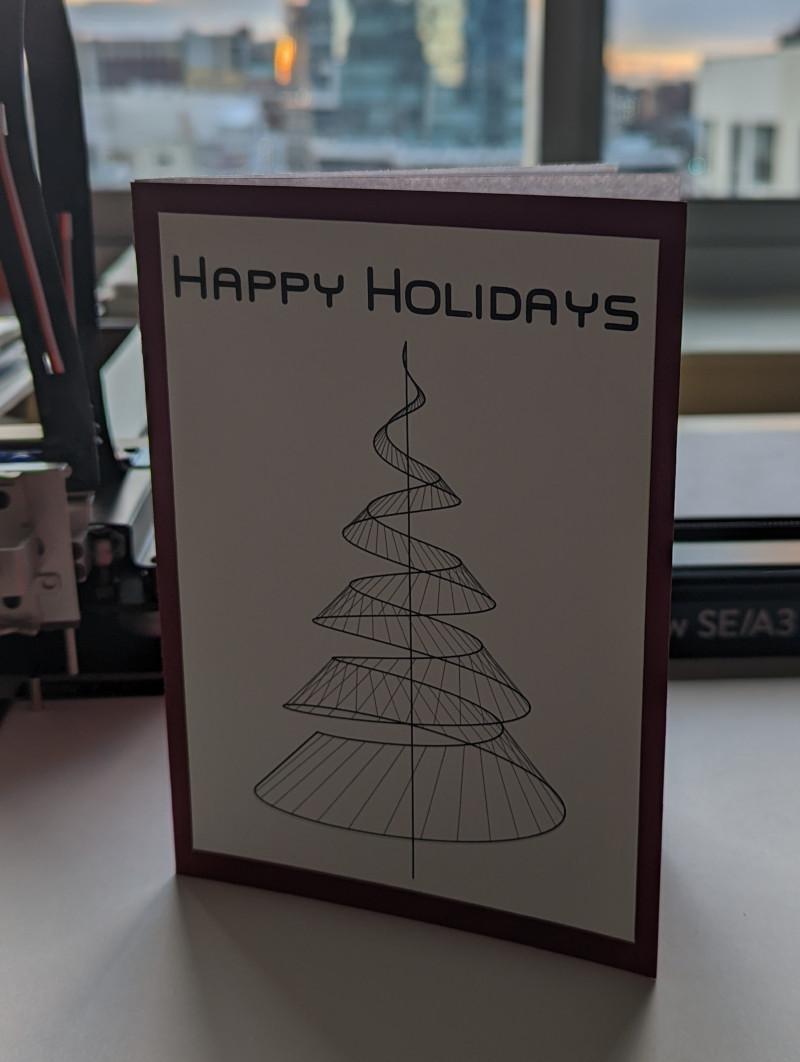Posts about programming
Happy Holidays!
Happy Holidays!
Like last year, I used my Axidraw to create my holiday cards. The results are even better this year:

New Py5Vector Class
Over the past few months, one of the most requested py5 features has been a dedicated vector class. Since there is a lot of interest, I wanted to build a draft version of a vector class that I am now making available for discussion with the growing py5 community.
The vector class code associated with this blog post is available on gist, but since this is an evolving process, the most current version will always be in the github repo. I've also created a discussion on github for feedback; please direct your comments and questions there. Feel free to comment or question anything you like. Update: the new Py5Vector class is complete and has been released. Visit the documentation website to learn how to use the Py5Vector class.
Happy Holidays!
Happy Holidays!
This year I used my new Axidraw to create my holiday cards. I'm very happy with the result:


Vectorization and Numpy
In this post I will discuss py5 performance tuning and the importance of vectorized operations.
Recently I saw this tweet by py5 supporter @villares:
Also #py5 @py5coding #Python3 #Processing
— Alexandre B A Villares☂🐍🧄 (@villares) August 31, 2021
I have to get used to -1 to 1 noise I suppose... :D
(check out Tristan's py5 + https://t.co/79JFm7tjvT tutorial: https://t.co/3mSb1wkG0V) pic.twitter.com/u4QH3zDM8Z
Better late than never Camera3D Release
A few days ago the Processing Foundation made the beta release of Processing 4 available for download. This was a great opportunity for me to review the Camera-3D and ColorBlindness libraries to make sure all of the example code works with the new version. I had to make some small changes here and there, as well as update some code to adapt to changes to the Shapes3D library. Everything now works and is ready for you to use in your creative projects.
Happy Holidays!
Happy Holidays!
This is the 3D animation I made for my holiday cards, using the open source library I've been building, py5. You'll need ChromaDepth glasses to see the 3D effect properly.
Music: This is Christmas by Scott Holmes Music.
The snowflakes are from the old and widely used WWFlakes font by WindWalker64.
The actual source code for this animation is available on github as a gist. This is a good example of how one can easily augment py5 with a Java Processing library.
This animation took some time to create because I first had to figure out how to implement ChromaDepth in Java. It's also the first time I did something notable in Processing using shaders, and that took some effort to learn. Shaders are a topic I've been wanting to explore for a long time and am happy I got the opportunity to do so while creating this. I'm also happy that py5 performed well during the development process. I didn't have to fix any bugs. Hooray!
Also have a look at the animations for 2015, 2016, and 2018. Those animations all require red-cyan anaglyph 3D Glasses.
Happy Holidays!
Happy Holidays!
This is the 3D animation I made for my holiday cards. View this with red-cyan 3D Glasses (red on the left, cyan on the right).
If you don't have 3D glasses you can watch the non-anaglyph version.
Camera3D and 360 Video
A new version of Camera3D has been released!
Version 1.2 supports 360 videos. Here is an example:
In addition, I made some performance improvements using new tools found in Java 1.8. Processing 2.x is no longer supported.
More information available on the Camera-3D Camera-3D project page.
Happy Holidays!
Happy Holidays!
This is the 3D animation I made for my holiday cards. View this with red-cyan 3D Glasses (red on the left, cyan on the right).
Also have a look at last year's animation.
Animations built with Processing and Camera-3D.
Carol Of The Bells by Jason Shaw of Audionautix is licensed under a Creative Commons Attribution license.
